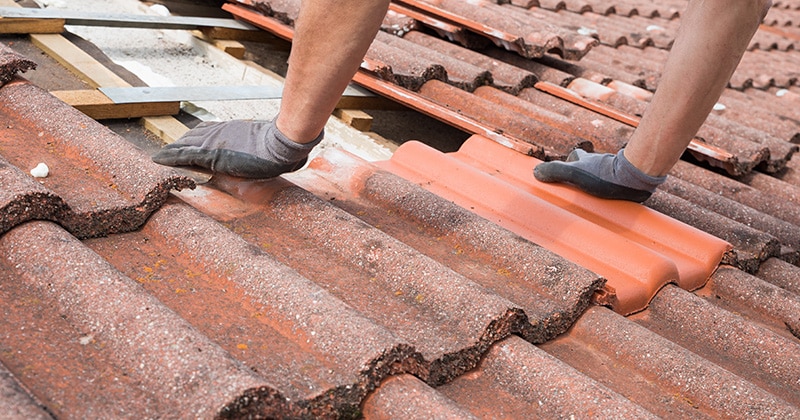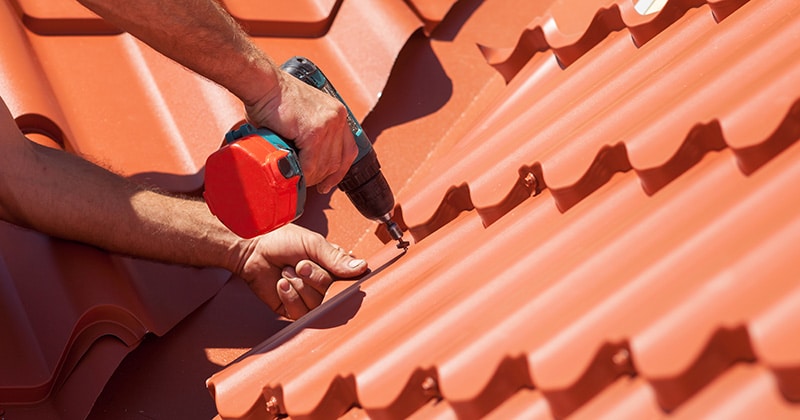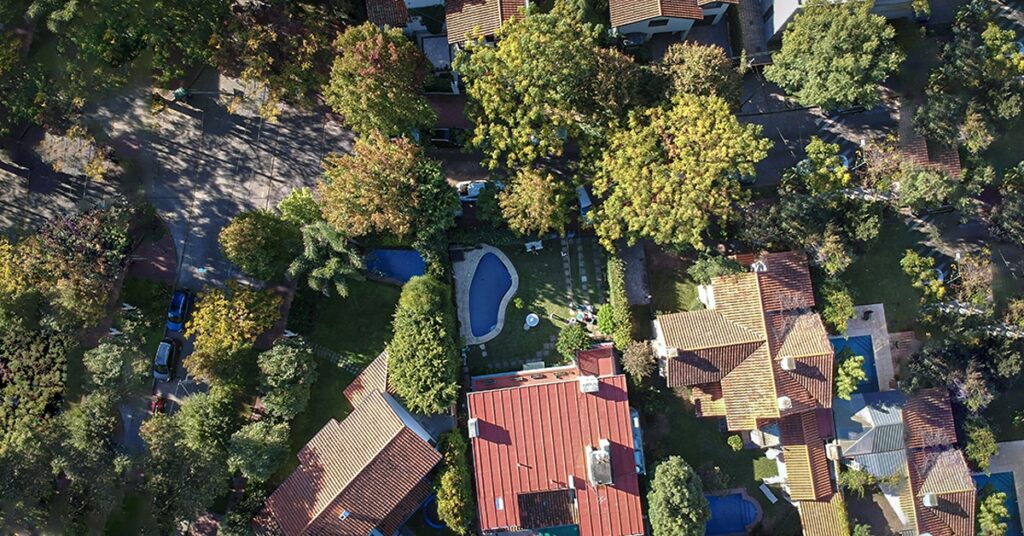There’s always more to learn, another trick or tip to have up your sleeve. That’s the beauty of being a roofer. You can continuously invest in your education to better your services.
So, if you’ve ever asked the question, “How long do tile roofs last?” this guide is for you.
We’ll explain why knowing the lifespan of roofing materials is essential. We’ll also debunk common myths about tiles. After that, we’ll explore everything related to their durability.
We’ll close with a couple of quick tips you can use to assess the lifespan of a tiled roof.
The guidance isn’t just theoretical! Whether you’ve been called in to inspect damage or install a new roof, this insight will make a concrete difference to the quality of your service.
Every improvement counts. So, let’s get started right now!
What’s the Importance of Understanding Tile Roof Longevity?
Your job is to serve your clients. This means giving them the information they need to make educated choices. It also means knowing what to look for and how to fix any problem that might occur.
That’s why it’s so crucial to understand the ins and outs of roof tile longevity. After all, roof tiles made from clay or concrete are popular. They’re a little heavier and more durable than other roofing options like asphalt shingles or metal.
They’re also a big investment. Installation ranges from $8,000 to $23,000. On average, a new tiled roof costs $15,500.
Your clients want to know they’re getting a good bang for their buck. And thanks to the benefits of roof tiles, they are.
What benefits exactly? Here are some of the most impactful:
- Durability: Tile roofs can last a long time, often 50 years or more.
- Aesthetic quality: Tile roofs come in many colors and styles.
- Cost-effective: Even though tile roofs can be expensive to install, they need less maintenance and last longer.
- Energy efficiency: Tile roofs can help keep homes cooler in the summer. The right color and material choice can reflect heat away.
- Fire resistance: Tiles are non-combustible, which means they don’t catch fire quickly.
- Low maintenance: Tile roofs don’t need a lot of upkeep. They are resistant to pests and rot.
When you know how to respond to questions about tiled roofs and their longevity, you can:
- Improve communication with your clients and set the right expectations early on.
- Offer personalized advice about maintenance.
- Build trust with your clients, as you look like the expert.
- Cater to unique preferences, like clients seeking environmentally friendly solutions.
- Drive business growth, as happy clients are more likely to leave positive reviews and recommend your services.
- Enhance your professional image and credibility.
FROM ONE OF OUR PARTNERS: 9 Roofing Trends to Watch in 2023

Common Misconceptions About Tile Roofs
You’ve probably heard rumors about tile roofs. Some of it may be true, but there’s a lot of misinformation out there.
Let’s clear up some common myths so you can give your clients accurate advice.
Misconception 1: Tile Roofs Leak When They Absorb Water
The truth: tile roofs are actually water-resistant.
And the tiles themselves? They don’t absorb water—quite the opposite. Proper installation and maintenance keep water out.
Underlayment and flashing also help keep things watertight.
Improve your service by:
- Using high-quality underlayment for added protection
- Inspecting and replacing damaged flashing to prevent leaks
Misconception 2: Tile Roofs Crack Easily Upon Impact
The truth: yes, tiles can crack. But it’s not a certainty. Modern tiles are made to withstand impact from hail and debris.
Plus, inspections can flag any cracks early. Replacement is quick and easy.
Improve your service by:
- Recommending tiles rated for impact resistance
- Looking at vulnerable areas like edges and ridges where impact damage is more likely
Misconception 3: Tile Roofs Overheat
The truth: tile roofs can make homes cooler. They reflect more sunlight than darker-colored asphalt shingles.
Plus, the gap under the tiles promotes airflow. This curbs heat buildup.
Improve your service by:
- Suggesting lighter-colored tiles for better heat reflection
- Checking the attic for good ventilation, as this contributes to the cooling benefits of the tiles
Misconception 4: Tile Roofs Are Too Heavy for Most Homes
The truth: most homes can support the weight of a tile roof. Builders keep this in mind during construction.
If you’re retrofitting an older home, you might suggest a structural assessment. The longevity of tile roofs makes this a worthwhile investment.
Improve your service by:
- Connecting your clients with a structural engineer before installing a tile roof on an older home
- Reinforcing the roof structure if needed
Misconception 5: Tile Roofs Require Constant Maintenance
The truth: tile roofs are low maintenance. All they need is a bit of cleaning and routine inspections.
Unlike other materials, tiles won’t rot. They can also stand up against destructive pests like rodents.
Improve your service by:
- Offering annual inspections to your clients
- Using a soft brush or low-pressure washer to clean tiles
FROM ONE OF OUR PARTNERS: Metal Roofs vs. Shingles: Which Should Roofers Recommend to Homeowners?

All About Tile Roof Longevity
Roof tiles are versatile, which is great news for your clients. Whatever their budget preference, there’s a long-lasting tile to suit.
Let’s look at six different types of roof tiles.
Concrete Roof Tiles
Concrete roof tiles are made from a mixture of sand, cement, and water. They are then molded under high pressure.
- Lifespan: 50-100 years
- Pros: Very durable against harsh weather and less expensive than other options.
- Cons: Heavier than other tiles.
Slate Roof Tiles
Slate roof tiles are made from natural slate stone. It’s split into thin, flat pieces.
- Lifespan: 75-200 years
- Pros: Extremely durable and resistant to fire and water. They offer a stunning, natural look.
- Cons: Very heavy and expensive. Installation and repair require specialized skills.
Metal Roof Tiles
Metal roof tiles are typically steel, aluminum, or copper. They are manufactured in the shape of traditional tiles.
- Lifespan: 40-70 years
- Pros: Lightweight, energy-efficient, and resistant to fire and insects.
- Cons: Can be noisy during rain or hail. They may dent under heavy impact.
Clay Roof Tiles
Clay roof tiles are crafted from natural clay. They are shaped and then fired in a kiln.
- Lifespan: 50-100 years
- Pros: Resistant to fire and rot. They also have excellent thermal properties, keeping homes cooler.
- Cons: More fragile and can crack under impact. They are also quite heavy.
Composite Roof Tiles
Composite roof tiles are made from a mixture of materials. This can include plastic, rubber, or wood fibers.
- Lifespan: 30-50 years
- Pros: Lightweight and hard-wearing. With slight variations, they mimic the look of natural tiles.
- Cons: Shorter lifespan and potentially more expensive.
Solar Roof Tiles
Finally, here’s an exciting innovation. Solar roof tiles generate electricity, just like traditional photovoltaic panels. But they look and function like standard roof tile.
- Lifespan: 25-30 years
- Pros: Generate electricity, reducing energy bills. They are eco-friendly and blend with the roof.
- Cons: High upfront cost. Their efficiency can decrease over time, which means they’ll generate less electricity.
RELATED ARTICLE: 9 Revolutionary New Roofing Technology Trends for 2024
Maintenance Best Practices for Tile Roofs
You might’ve noticed above that, when listing the lifespan of each tile type, we gave a range. That’s because every roof is unique. The climate is different, and there are likely a few installation or construction quirks at play too.
How can you make sure the roofs you work on last as long as possible? In a word, maintenance.
Here are some best practices to offer to clients:
- Trim trees and branches. Overhanging branches can fall and damage tiles. They can also drop leaves and debris. Over time, this leads to a buildup of water. You can offer this service to your clients. Or you can recommend a tree-trimming schedule.
- Remove debris. Debris like leaves and twigs can trap moisture. When water just sits there, mold can develop. Before installation, remove all debris. Give your clients some tips on how they can keep this up.
- Clean gutters. Notice a bit of a theme here? The whole roof area—gutters included—should be kept clean. Clogged gutters can cause water to back up. This can wreak havoc on the roof edge and underlayment.
- Offer annual inspections. Roofing work can be dangerous. Your client might not want to spend their weekend dealing with ladders and gutter cleaners. Create an annual inspection plan for clients instead. This will save them the headache and make their roof last.
- Check for broken tiles. Cracked tiles can let water in, damaging the underlayment and structure. Replace any damaged tiles immediately. This stops the problem from getting any worse.
- Use protective coatings. Some tiles benefit from protective coatings that repel water and reduce wear. Suggest these to your clients, based on their needs.
Top Tips for Assessing the Longevity of a Tile Roof
How long do tile roofs last? Now you know.
Here are four actions you can take to assess the longevity of your client’s tile roof:
- Inspect regularly. Schedule inspections at least once or twice a year to check for damaged or missing tiles.
- Check underlayment. See if the underlayment is intact. Damaged underlayment can lead to leaks.
- Examine flashing. Inspect the flashing around chimneys, vents, and skylights. It should be secure and free of rust or damage.
- Clear the roof. Remove leaves, twigs, and other debris from the roof and gutters to stop water from pooling.


